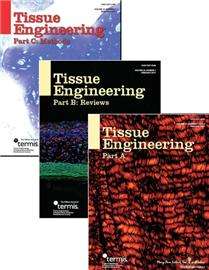Credit: Mary Ann Liebert, Inc., publishers
Researchers have shown that a novel cage constraint can prevent engineered cartilage from swelling during growth in culture, leading to better collagen stability and enhanced functional properties of the cartilage. The innovative cage system, designed to limit growth of engineered tissues within a fixed volume and shape while providing sufficient nutrients, is described in an article in Tissue Engineering, Part A.
Robert Nims, Gerard Ateshian, PhD, and coauthors from Columbia University, New York, NY, created the cage constraint system for growing engineered cartilage in culture to overcome the common problem of osmotic swelling pressure, which destabilizes immature collagen, inhibiting the development of a strong collagen framework needed to support cartilage formation. The researchers studied the growth of engineered cartilage constructs in two different types of scaffolds—agarose and cartilage-derived matrix hydrogel—and compared it to unconstrained growth.
In the article entitled "Constrained Cage Culture Improves Engineered Cartilage Functional Properties by Enhancing Collagen Network Stability," the authors report the differences in swelling-induced expansion, functional properties, and collagen content of the cartilage constructs grown in the two types of scaffolds or under unconstrained conditions.
"The management of mechanical forces in the development of engineered tissues is emerging as an important aspect of control. In this study, three-dimensional constraint is shown to make an important contribution to appropriate tissue maturation," says Tissue Engineering Co-Editor-in-Chief Peter C. Johnson, MD, Principal, MedSurgPI, LLC and President and CEO, Scintellix, LLC, Raleigh, NC.
More information: Robert J. Nims et al, Constrained Cage Culture Improves Engineered Cartilage Functional Properties by Enhancing Collagen Network Stability, Tissue Engineering Part A (2017). DOI: 10.1089/ten.tea.2016.0467
Provided by Mary Ann Liebert, Inc




















